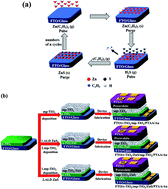Double layer mesoscopic electron contact for efficient perovskite solar cells†
Abstract
Interface engineering has emerged as a great strategy for fabrication of high efficiency and stable perovskite solar cells (PSCs). Here, we deposit a thin layer of ZnS as a buffer layer at the interface of the perovskite absorber and electron transporting layer (ETL) using the atomic layer deposition (ALD) process. The impact of the ZnS layer on the photovoltaic characteristics of PSCs was investigated by comparison of two mesoscopic configurations, in which the ZnS layer is grown on compact TiO2 and on mesoporous TiO2 surfaces. Our results revealed that the addition of an ultrathin ZnS layer between the perovskite and ETL drastically improves the charge extraction properties and reduces interface recombination. Moreover, we demonstrate that the deposition of an optimum ZnS layer (with a thickness of 1.8 nm) on top of the mesoporous TiO2 surface has the best effect on the improvement of the photovoltaic performance of PSCs, yielding a champion efficiency of 19.10% with negligible hysteresis. These results indicate that interface engineering with the ZnS film deposited by ALD is an effective approach toward highly efficient and reproducible PSCs.



 Please wait while we load your content...
Please wait while we load your content...